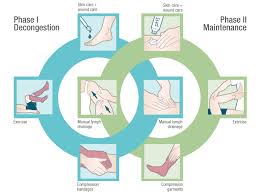Being involved in lymphedema management for over 30 years, I would like to discuss the importance of appropriate dosing levels for lymphedema treatments, in other words, how many treatments per week should ideally be applied in Phase I, or the intensive phase of Complete Decongestive Therapy (CDT).
CDT is performed in two phases; in phase one, also known as the intensive or decongestive phase, treatments are administered by trained lymphedema therapists ideally on a daily basis until the affected body part is decongested.

Components of CDT
The end of the first phase of CDT is determined by the results of measurements on the affected body part, which are taken by the therapist. Once measurements approach a plateau, the end of phase one is reached and the patient progresses seamlessly into phase two of CDT, also known as the self-management phase. Phase two is an ongoing and individualized part of CDT, in which the patient assumes responsibility for maintaining and improving the treatment results achieved in phase one.
In the Position Statement of the National Lymphedema Network for the Diagnosis and Treatment of Lymphedema1, it is stated that “Optimally, CDT should be performed daily (5 days/week) until the reduction of fluid volume has reached a plateau, which can take 3 to 8 weeks. Some patients may have good results from CDT with modifications of the frequency and duration of treatment. CDT frequency and duration should be individualized to produce the greatest reduction of swelling and improvement of skin condition in the shortest period of time.”
The International Lymphedema Framework’s Best Practice for the Management of Lymphoedema 2 states that “Patients undergoing standard intensive therapy must be carefully selected and be willing and able to commit physically and emotionally to daily intensive therapy, including participation in exercise programs.”
I do agree with both statements; the best results in lymphedema treatment, also in my experience, are achieved if treatments are given on a daily basis, Monday through Friday.
Will there be exceptions? Certainly. Every case of lymphedema is different, and there is no clear-cut approach to treatment. Treatment frequency and intensity depends on a multitude of factors, such as severity and stage of the swelling, the age and general physical condition of the patient, as well as existing co-morbidities, such as congestive heart failure (CHF), diabetes, etc.
There are also health care-related limitations, such as out-of pocket expenses (co-payments for treatments, cost for compression supplies), transportation issues and general healthcare limits, which unfortunately seem to be the main reason for limitations and sub-optimal dosing for lymphedema treatment at this time.
 In a national survey labeled “Lymphedema Therapists’ Dosing of CDT in Breast Cancer Survivors with Lymphedema“3, published December 2017 on the Internet Journal of Allied Health Sciences and Practice (IJAHSP), it was reported that, in regard to the frequency, the average number of patient visits per week during Phase 1 of CDT was 3.71, according to the Physical Therapists, Occupational Therapists, Physical Therapist Assistants and Occupational Therapists Assistants trained in lymphedema therapy, that participated in that survey.
In a national survey labeled “Lymphedema Therapists’ Dosing of CDT in Breast Cancer Survivors with Lymphedema“3, published December 2017 on the Internet Journal of Allied Health Sciences and Practice (IJAHSP), it was reported that, in regard to the frequency, the average number of patient visits per week during Phase 1 of CDT was 3.71, according to the Physical Therapists, Occupational Therapists, Physical Therapist Assistants and Occupational Therapists Assistants trained in lymphedema therapy, that participated in that survey.
This number is clearly below the recommended weekly dosage for CDT in Phase I. However, I am not surprised by that number; I frequently hear from certified lymphedema therapists, that oftentimes these therapists are pressured by their employers to treat patients only 2 or 3 times per week.
Evidence-based treatment protocols and comparative clinical outcome studies for optimal dosage levels for CDT are certainly necessary; however, based not only on my own experience and observation, CDT is most effective if performed 5 times per week for a minimum of two weeks in most patients. After that, treatment dosage may be reduced to 3 times per week, if necessary, until the lymphedema is decongested, and the patient can be measured for a compression garment4. The most substantial reduction in lymphedema volume generally occurs within the first 3 days of treatment.
Patients should be treated Monday through Friday and instructed to wear the bandages over the treatment-free weekend. Adherence to this recommended dosage will yield better treatment outcomes and less overall treatment visits.
If treatments are applied only 2 to 3 times a week, the patient may be without treatment for 3 or 4 days that week – in that case, patients and therapists are fighting an uphill battle caused by sliding bandages in days without treatment and subsequent re-accumulation of fluid in the affected extremity. This will inevitably lead to poor treatment outcomes, increased overall length of treatment time and patient visits, as well as frustration on both the therapists’ and the patients’ side.
One of the main reasons for not following the daily recommended dosing of CDT listed in the IJAHSP3 survey, was that the therapists’ dosage determination was impacted by their perception of the patients’ readiness and adherence to lymphedema treatment and self-management.
Patient motivation and compliance are imperative to achieve optimal treatment results; it is therefore necessary to explain the treatment protocol and recommended dosage to the patient. Patients need to be aware that less than 5 treatment sessions per week during the first two weeks of Phase I will lead to an increased number of treatments sessions and longer overall treatment time.
Most informed patients will recognize that trading a decreased number of weekly visits in exchange for a much-increased overall treatment time with most likely poorer results, is a bad deal.
Click here for a short video explaining the correct dosing for Complete Decongestive Therapy
Informed patients will be more motivated and ready to make themselves available and arrange for transportation during that time if necessary.
Dear Lymphedema Blog Reader – if you like the contents on this website, please help to keep it going. A great amount of work and research is necessary to provide you with up-to-date information on this site. Your donation supports these efforts and associated administrative costs. Surplus funds will be donated to Lymphedema/Lipedema-related charitable endeavors. Please donate using the “Donate Now” button on the right upper hand of this page – Thank You!
Join Lymphedema Guru, a Facebook page solely dedicated to inform about all things related to lymphedema – news, support groups, treatment centers, and much more


 Joachim Zuther, Lymphedema Specialist.
Joachim Zuther, Lymphedema Specialist. 

Thank you, thank you, thank you for this article. This cannot be stated strongly enough. We have to advocate for our patients for appropriate treatment dosage, whether it be with hospital/clinic administrations or insurance companies. We would never tell a patient to take their medications 2 or 3 days a week instead of every day, this is no less important.